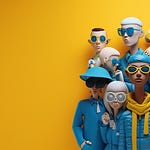Read the publication below or watch on Youtube.
This week marked a significant milestone for Unikcracy, as I officially kicked off the project with two foundational publications.
On Tuesday, in "Why Should Anyone Pay Attention to Your Creative Work?", I explored the essential concept of Uniqueness. I discussed why simply being talented or producing beautiful designs isn't enough anymore. In today's saturated marketplace, your ability to be intentionally and strategically unique is crucial, not only for your personal brand but also for clearly differentiating your clients. The article covers how intentional uniqueness creates invaluable competitive advantages, helping your creative projects truly stand out. If you haven't read it yet, I encourage you to dive in. You'll discover insights that could profoundly shift your creative approach. Check out the publication here.
On Thursday, in "Forget What You Know: What Does Creativity Really Mean?", I challenged traditional perceptions about creativity. There's a persistent myth that creativity is some mystical gift reserved for a select few. In this article, I broke down that myth, demonstrating how creativity is actually a structured, learnable skill. It’s about intentionality, structured thinking, methodologies, and consistent practice, not random inspiration. By understanding creativity clearly and practically, you can unlock your true creative potential. If you missed it, I invite you to read the article and redefine how you approach creativity from now on. Check out the publication here.
Today, I'd like to reflect briefly on these two essential pillars, Uniqueness and Creativity, and discuss how they come together in what I define as NextGen Creativity. It's a vision of creativity that's already reshaping our roles as creative professionals, radically transforming our processes, and redefining the creative industry itself.
What Is NextGen Creativity?
NextGen Creativity is the evolution of creativity as we traditionally know it. It's a radical shift away from the old assumption that creativity depends on inherent talent or spontaneous inspiration, moving toward structured frameworks, deliberate creative processes, and intentional differentiation.
Creativity is no longer magical or mysterious. It's practical, learnable, and intentional. But, more importantly, creativity has become the critical medium for achieving uniqueness, the indispensable differentiator clients and audiences crave in today's crowded and noisy marketplace.
As creatives (whether graphic designers, fashion designers, interior designers, architects, content creators, or brand strategists), we're witnessing significant changes. Our work has become less about expressing our personal artistic preferences and more about rapidly responding to precise project requirements, strict deadlines, and strategically differentiating our work.
Throughout my career, both as a designer and educator, I've repeatedly observed the persistent myth that creativity is primarily about talent and spontaneous inspiration. Aspiring designers quickly discover the harsh reality: creativity isn't about their personal inspirations or artistic passions. It's a professional job that demands structured processes, rapid ideation, and strategic differentiation.
Without clear methodologies, structured frameworks, or full control over visual communication, it's virtually impossible to thrive professionally as a creative. Unfortunately, many creatives fall into the trap of using visual "inspiration" platforms to copy existing trends, inadvertently compromising their uniqueness and diluting authentic creativity.
AI, Automation, and Templates: Game-Changers of Creativity
Artificial Intelligence isn't the only force reshaping the creative industry today. Automation and user-friendly template tools like Canva have also dramatically impacted creative workflows, significantly altering the value and perception of creative work itself.
Platforms that provide ready-made templates and automated design tools enable anyone, even those without specialized skills or design experience, to quickly produce visually appealing content. While this accessibility is fantastic in terms of productivity and democratization, it comes at a cost: much of the output is repetitive, predictable, and lacking differentiation. This abundance of "more of the same" has created an illusion that hiring experienced creatives is no longer necessary, since anyone can replicate visually pleasing designs in minutes.
AI tools push this dynamic even further. Traditionally, developing a creative concept involved extensive research and meticulous visual production. Now, creators simply input instructions or visual guidelines into AI-driven platforms to generate multiple high-quality visual proposals instantly. What previously took hours or even days of creative exploration and refinement now happens in mere minutes, providing countless variations to choose from.
The real issue here is that while automation and template tools speed up production, they often eliminate strategic thinking, differentiation, and true uniqueness. When the creative process is reduced to simply choosing from pre-made templates or quickly generated AI visuals, there's little room left for genuine creative ideation, meaningful storytelling, or strategic uniqueness.
Today's designers increasingly find themselves in the role of curators or creative directors rather than traditional producers. Instead of manually crafting each visual element, their primary responsibility is defining strategic directions, establishing clear visual frameworks, and curating the output provided by automated tools or AI platforms.
This profound shift from skilled production to strategic curation defines what I call NextGen Creativity. It's no longer enough to produce visually appealing work. The real value lies in strategically guiding these technologies, intentionally steering creative processes toward differentiated, meaningful, and uniquely impactful outcomes.
Throughout much of my design career, countless hours were spent manually crafting concepts from scratch, relying on extensive visual research, detailed planning, and meticulous execution. I now invest my time defining clear strategic directions, developing visual communication frameworks, and generating multiple conceptual iterations quickly through AI. This role transition, from a hands-on designer to a strategic creative director, mirrors the entire industry's current trajectory.
No longer do I spend days manually visualizing concepts. Instead, I leverage technology to rapidly prototype, iterate, and produce intentional uniqueness. It's an exciting evolution, one that aligns perfectly with the philosophy of strategic creativity that Unikcracy embodies. This isn't just my personal experience; leading studios like Zaha Hadid Architects are also embracing this same strategic approach.
Still, it's crucial to highlight a key point: neither traditional nor AI-driven creative processes automatically guarantee genuine creativity. Historically, designers have always reused existing visual elements and styles to respond quickly to client demands. Today, AI rapidly produces visuals based purely on provided instructions, something any client could potentially deliver. What's genuinely missing in both scenarios is intentional ideation and a robust, structured creative process deliberately designed to foster strategic differentiation.
Clients today demand far more than aesthetically pleasing visuals; they require clear differentiation, strategic purpose, and memorable uniqueness. That's precisely why structured creative frameworks and methodologies, topics I'll explore deeply in upcoming publications, are now essential. Merely being talented or aesthetically sophisticated no longer suffices. Instead, strategic control over your creative process and rapid ideation capabilities will define your professional success.
What's Coming Next at Unikcracy
Unikcracy exists precisely to guide and empower you through this rapid transformation in creativity. My commitment is clear: to provide strategic frameworks, effective methodologies, practical techniques, and creative processes specifically designed to leverage AI effectively, empowering you to achieve consistent intentional uniqueness.
We're entering a creative future that looks drastically different from anything we've previously known. At Unikcracy, I'm here to guide you through this transition, ensuring your creativity remains relevant, impactful, and professionally indispensable.
Quick Reminder: Special April Launch Offer (£5/month)
If you're serious about embracing intentional creativity, now's the perfect time. Right now, during April only, you can lock in full access to Unikcracy's exclusive premium content for just £5 per month. Starting in May, prices will rise, and premium content becomes exclusive to paid subscribers.
Don't miss the opportunity to gain strategic frameworks, methods, insights, and techniques that clearly differentiate your creativity and professional work.
Lock in Your Launch Price & Subscribe Now for £5/month!
Offer ends April 30—don’t miss out!
Join the alliance of creatives. Let's start creating uniqueness.
Gerard Puxhe
Founder, Unikcracy
Creative Director, Designer, Educator














Share this post